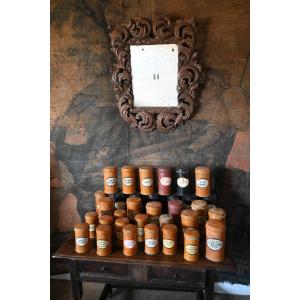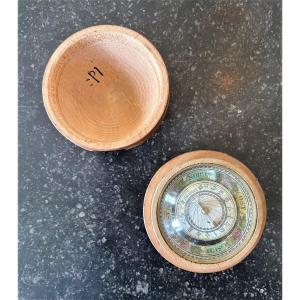This elegant precision scale was manufactured in France around 1800 to 1850 and is specifically designed to weigh gold coins commonly circulated in 19th-century Europe. It is in remarkable condition and fully functional, preserved in its original period case and complete with its full set of weights, making it a highly collectible rarity.
The case, of elongated oval shape, is crafted in wood covered with leather, now gently worn with age, adding character and authenticity. Inside, it is lined with deep red velvet that remains vibrant, offering a striking contrast with the bronze weights nestled securely in their compartments. The velvet lining, aside from its visual appeal, also protected the scale components during transport and use.
The scale itself consists of a simple metal crossbar with two circular pans suspended by cords. It is a straightforward mechanism, typical of portable scales used by jewelers, goldsmiths, and moneychangers. To use, one would hang it from a stable hook, place the coin on one pan, and add weights to the other until balance was achieved, a quick and effective way to verify the exact weight and, therefore, the value of gold coins.
The set of weights is particularly interesting. Each is clearly engraved with the name of the coin it corresponds to, including well-known examples such as French Louis (“LOUIS”), Austrian ducats (“DUC”), Neapolitan escudos, imperial coins, and British sovereigns (“SOVEREIGN”), among others. These inscriptions confirm the scale's authenticity and its intended professional use.
More than a scientific instrument, this scale is a historical witness to the international gold trade. Its well-preserved condition and intact set make it highly desirable for collectors of antique scientific tools or those seeking historical décor. It's one of those pieces that spark conversation, evoke past eras, and add a unique charm to any private collection.
An exceptional opportunity to acquire a rare historical piece, perfect for a study, a library, or to enhance an antique collection.
Measurements: 22.5 × 10.5 cm (8.85 × 4.13 in).
History of gold coin scales
Throughout the 18th and 19th centuries, portable precision scales like this one were essential tools for jewelers, bankers, and moneychangers. Given the wide variety of gold coins in circulation across Europe, each with different weights and values, a reliable and accurate method to verify authenticity and weight was crucial. These balances helped detect counterfeit or shaved coins, common practices to diminish gold content while maintaining visual appearance.
In France, such devices were called “balances de changeur”, and were indispensable in trading hubs like Paris and Marseille. They were manufactured with meticulous precision and came with weight sets corresponding to the most commonly used gold coins of the time, including Louis, escudos, ducats, and sovereigns. The engraved coin names on each weight reflect not only their function, but also the expertise of the professional using them.
Today, these scales are highly prized by collectors for their historical and aesthetic value. They embody the intersection of commerce, science, and craftsmanship during a fascinating period in economic history.



























 Le Magazine de PROANTIC
Le Magazine de PROANTIC TRÉSORS Magazine
TRÉSORS Magazine Rivista Artiquariato
Rivista Artiquariato